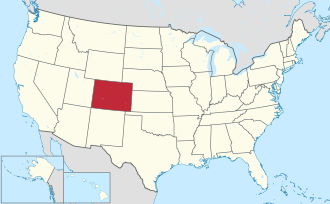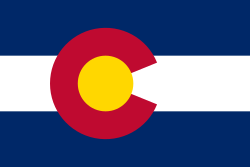Colorado stands as a mountainous state in the Western United States, encompassing diverse landscapes from the Rocky Mountains to high plains1. The state borders Wyoming to the north, Nebraska to the northeast, Kansas to the east, Oklahoma to the southeast, New Mexico to the south, Arizona to the southwest, and Utah to the west1. Colorado’s territory spans 104,094 square miles, making it the eighth-largest U.S. state by area1.
History Encompasses Indigenous Heritage Through Modern Statehood
Native Americans Inhabited Colorado’s Territory for Millennia
Native Americans and their Paleoamerican ancestors inhabited Colorado’s region for at least 13,500 years and possibly more than 37,000 years1. The Ute Nation occupied the mountain valleys of the Southern Rocky Mountains and the Western Rocky Mountains, extending as far east as the Front Range1. The Apache and Comanche tribes controlled the Eastern and Southeastern parts of the state1. The Arapaho and Cheyenne moved west from the Great Lakes region in the 17th century to hunt across Colorado’s High Plains1.
Spanish Empire Claimed Colorado as Part of Nuevo México
The Spanish Empire claimed Colorado as part of Nuevo México during colonial times1. Spanish priest Silvestre Vélez de Escalante recorded in 1776 that Native Americans in the area knew the river as el Rio Colorado for the red-brown silt that the river carried from the mountains1. The U.S. acquired the territorial claim to the eastern Rocky Mountains with the Louisiana Purchase from France in 18031.
Territory Act Created Colorado Territory in 1861
President James Buchanan signed an Act of Congress organizing the free Territory of Colorado on February 28, 18611. The original boundaries of Colorado remain unchanged except for government survey amendments1. The Pike’s Peak Gold Rush of 1858–1862 created an influx of settlers to the region1.
Statehood Established Colorado as the Centennial State
President Ulysses S. Grant signed Proclamation 230 on August 1, 1876, admitting Colorado to the Union as the 38th state1. Colorado earned the nickname “Centennial State” because it became a state 100 years and four weeks after the signing of the United States Declaration of Independence1. The discovery of a major silver lode near Leadville in 1878 triggered the Colorado Silver Boom1.
Twentieth and Twenty-first Centuries Brought Industrial and Social Changes
Poor labor conditions resulted in several major clashes between strikers and the Colorado National Guard, including the 1903–1904 Western Federation of Miners Strike and Colorado Coalfield War1. The Ku Klux Klan Colorado Realm achieved dominance in Colorado politics in 1924, with peak membership levels controlling both local and state Democrat and Republican parties1. Colorado became the first western state to host a major political convention when the Democratic Party met in Denver in 19081.
Geography Features Diverse Landscapes and Climate Zones
Plains Cover Eastern Colorado’s Agricultural Region
Eastern Colorado consists of the Colorado Eastern Plains of the High Plains, the section of the Great Plains within Colorado at elevations ranging from roughly 3,350 to 7,500 feet1. The Colorado plains are mostly prairies but also include deciduous forests, buttes, and canyons1. Precipitation averages 15 to 25 inches annually in this region1.
Front Range Contains Colorado’s Population Centers
The Front Range Urban Corridor houses roughly 70% of Colorado’s population along the eastern edge of the Rocky Mountains between Cheyenne, Wyoming, and Pueblo, Colorado1. The Front Range includes Denver, Boulder, Fort Collins, Loveland, Castle Rock, Colorado Springs, Pueblo, Greeley, and other townships and municipalities1.
Mountains Dominate Colorado’s Western Regions
The Rocky Mountains within Colorado contain 53 true peaks and 58 named peaks that are 14,000 feet or higher in elevation above sea level, known as fourteeners1. Mount Elbert at 14,437.6 feet elevation in Lake County is the highest point in Colorado and the Rocky Mountains of North America1. Colorado is the only U.S. state that lies entirely above 1,000 meters elevation1.
Continental Divide Separates Colorado’s Watersheds
The Continental Divide of the Americas extends along the crest of the Rocky Mountains1. The area of Colorado to the west of the Continental Divide is called the Western Slope of Colorado1. West of the Continental Divide, water flows to the southwest via the Colorado River and the Green River towards the Gulf of California1.
South Central Region Contains the San Luis Valley
The large San Luis Valley in south-central Colorado contains the headwaters of the Rio Grande1. The northern part of the valley is the San Luis Closed Basin, an endorheic basin that helped create the Great Sand Dunes1. The valley sits between the Sangre de Cristo Mountains and San Juan Mountains1.
Western Slope Includes Diverse Terrains and Climates
The Western Slope of Colorado includes the western face of the Rocky Mountains and all of the area to the western border1. This area includes several terrains and climates from alpine mountains to arid deserts1. Grand Junction, Colorado, at the confluence of the Colorado and Gunnison Rivers, is the largest city on the Western Slope1.
Climate Varies Significantly Across Colorado’s Regions
Eastern Plains Experience Semi-arid Climate Conditions
The climate of the Eastern Plains is semi-arid with low humidity and moderate precipitation, usually from 15 to 25 inches annually1. The area is known for its abundant sunshine and cool, clear nights, which give this area a great average diurnal temperature range1. The Front Range urban corridor lies in a pronounced precipitation shadow as a result of being on the lee side of the Rocky Mountains1.
Front Range Foothills Display Climate Variety
Front Range foothills contain a wide variety of climate types1. Locations merely a few miles apart can experience entirely different weather depending on the topography1. Most valleys have a semi-arid climate, not unlike the eastern plains, which transitions to an alpine climate at the highest elevations1.
Extreme Weather Occurs Throughout Colorado
Extreme weather changes are common in Colorado, although a significant portion of the extreme weather occurs in the least populated areas of the state1. The Eastern Plains are part of the extreme western portion of Tornado Alley1. Notable examples include the severe hailstorms that hit Denver on July 11, 1990, and May 8, 20171.
Climate Change Affects Colorado’s Environment
Climate change in Colorado encompasses the effects attributed to man-made increases in atmospheric carbon dioxide1. The United States Environmental Protection Agency reported that heat waves are becoming more common, snow is melting earlier in spring, and less water flows through the Colorado River1. Rising temperatures and recent droughts have killed many trees by drying out soils, increasing the risk of forest fires1.
Records Show Temperature Extremes
The highest official ambient air temperature ever recorded in Colorado was 115 °F on July 20, 2019, at John Martin Dam1. The lowest official air temperature was −61 °F on February 1, 1985, at Maybell1.
Earthquakes Occur Despite Mountainous Terrain
Colorado experiences less seismic activity than states like California and Alaska despite its mountainous terrain1. There are over 90 potentially active faults, and since 1867, Colorado has experienced 700 recorded earthquakes of magnitude 2.5 or higher1. The U.S. National Earthquake Information Center is located in Golden1.
Fauna Includes Native and Reintroduced Species
Gray wolves were extirpated from Colorado through trapping and poisoning in the 1930s, with the last wild wolf shot in 19451. A wolf pack recolonized Moffat County, Colorado in northwestern Colorado in 20191. Coloradans voted to reintroduce gray wolves in 2020, with the state committing to a plan to have a population by 20221.
Mountain goats are not native to Colorado but were introduced to the state between 1947 and 19721. Despite being an artificially-introduced species, the state declared mountain goats a native species in 19931. The native population of pronghorn in Colorado reached a low of only 15,000 individuals during the 1960s but recovered to roughly 66,000 by 20131.
Common wildlife found in Colorado’s mountains include mule deer, southwestern red squirrel, golden-mantled ground squirrel, yellow-bellied marmot, moose, American pika, and red fox1. The foothills include deer, fox squirrel, desert cottontail, mountain cottontail, and coyote1. The prairies are home to black-tailed prairie dog, the endangered swift fox, American badger, and white-tailed jackrabbit1.
State Government Operates Under Three Branches
State Executive Officers Lead Colorado’s Administration
Jared Polis, a Democrat, serves as the current Governor of Colorado1. Colorado’s other statewide elected executive officers include the Lieutenant Governor of Colorado, Secretary of State of Colorado, Colorado State Treasurer, and Attorney General of Colorado, all serving four-year terms1.
The seven-member Colorado Supreme Court serves as the state’s highest court1. The Colorado Court of Appeals, with 22 judges, sits in divisions of three judges each1. Colorado is divided into 23 judicial districts, each with a district court and a county court with limited jurisdiction1.
The Colorado General Assembly comprises two houses – the House of Representatives and the Senate1. The House has 65 members and the Senate has 351. As of 2023, the Democratic Party holds a 23 to 12 majority in the Senate and a 46 to 19 majority in the House1.
Politics Show Democratic Trends in Recent Elections
Colorado was once considered a swing state but has become a relatively safe blue state in both state and federal elections since the late 2010s1. In presidential politics, Colorado was considered a reliably Republican state during the post-World War II era, voting for the Democratic candidate only in 1948, 1964, and 19921. Since the mid-2000s, it has swung heavily to the Democrats, voting for Barack Obama in 2008 and 2012, Hillary Clinton in 2016, Joe Biden in 2020, and Kamala Harris in 20241.
Colorado politics exhibits a contrast between conservative cities such as Colorado Springs and Grand Junction, and liberal cities such as Boulder and Denver1. Democrats are strongest in metropolitan Denver, the college towns of Fort Collins and Boulder, southern Colorado including Pueblo, and several western ski resort counties1.
Significant Initiatives Demonstrate Progressive Legislation
Colorado was the first state in the union to enact, by voter referendum, a law extending suffrage to women on November 7, 18931. In 2012, voters amended the state constitution protecting the “personal use” of marijuana for adults, establishing a framework to regulate cannabis like alcohol1. The first recreational marijuana shops in Colorado opened their doors on January 1, 20141.
Counties Organize Colorado’s Local Government
The State of Colorado is divided into 64 counties1. Two of these counties, the City and County of Broomfield and the City and County of Denver, have consolidated city and county governments1. Counties are important units of government in Colorado since there are no civil townships or other minor civil divisions1.
El Paso County, home to Colorado Springs, is the most populous county in Colorado1. The City and County of Denver, the state capital, is the second most populous county1. Five of the 64 counties have more than 500,000 residents, while 12 have fewer than 5,000 residents1.
Municipalities Include Cities, Towns, and Consolidated Governments
Colorado has 273 active incorporated municipalities, comprising 198 towns, 73 cities, and two consolidated city and county governments1. At the 2020 United States census, 4,299,942 of the 5,773,714 Colorado residents lived in one of these municipalities1. The most populous municipality is the City and County of Denver1.
Colorado has 12 municipalities with more than 100,000 residents, and 17 with fewer than 100 residents1. The 16 most populous Colorado municipalities are all located in the Front Range Urban Corridor1. The City of Grand Junction is the most populous municipality on the Colorado Western Slope1.
Unincorporated Communities Supplement Municipal Areas
Colorado has 210 unincorporated census-designated places and many other small communities1. The most populous unincorporated community in Colorado is Highlands Ranch south of Denver1. The seven most populous CDPs are located in the Front Range Urban Corridor1. The Clifton CDP is the most populous CDP on the Colorado Western Slope1.
Citations:
zglos
Colorado is a state in the Western United States. It is one of the Mountain states, sharing the Four Corners region with Arizona, New Mexico, and Utah. It is also bordered by Wyoming to the north, Nebraska to the northeast, Kansas to the east, and Oklahoma to the southeast. Colorado is noted for its landscape of mountains, forests, high plains, mesas, canyons, plateaus, rivers, and desert lands. It encompasses most of the Southern Rocky Mountains, as well as the northeastern portion of the Colorado Plateau and the western edge of the Great Plains. Colorado is the eighth-largest U.S. state by area and the 21st by population. The United States Census Bureau estimated the population of Colorado to be 5,957,493 as of July 1, 2024, a 3.2% increase from the 2020 United States census.
Colorado | |
|---|---|
| Nicknames: | |
| Motto(s): Nil sine numine (English: Nothing without providence) | |
| Anthem: Where the Columbines Grow and Rocky Mountain High | |
 Location of Colorado within the United States | |
| Country | United States |
| Before statehood | Territory of Colorado |
| Admitted to the Union | August 1, 1876 (38th) |
| Capital (and largest city) | Denver |
| Largest county or equivalent | El Paso |
| Largest metro and urban areas | Denver |
| Government | |
| • Governor | Jared Polis (D) |
| • Lieutenant Governor | Dianne Primavera (D) |
| Legislature | General Assembly |
| • Upper house | Senate |
| • Lower house | House of Representatives |
| Judiciary | Supreme Court (list) |
| U.S. senators | Michael Bennet (D) John Hickenlooper (D) |
| U.S. House delegation | 4 Democrats 4 Republicans (list) |
| Area | |
• Total | 104,185 sq mi (269,837 km2) |
| • Land | 103,718 sq mi (268,875 km2) |
| • Water | 376 sq mi (962 km2) 0.36% |
| • Rank | 8th |
| Dimensions | |
| • Length | 280 mi (451 km) |
| • Width | 380 mi (612 km) |
| Elevation | 6,800 ft (2,070 m) |
| Highest elevation | 14,440 ft (4,401.2 m) |
| Lowest elevation | 3,317 ft (1,011 m) |
| Population (2024) | |
• Total | |
| • Rank | 21st |
| • Density | 56.25/sq mi (21.72/km2) |
| • Rank | 37th |
| • Median household income | $92,900 (2023) |
| • Income rank | 9th |
| Demonym | Coloradan |
| Language | |
| • Official language | English |
| Time zone | UTC−07:00 (MST) |
| • Summer (DST) | UTC−06:00 (MDT) |
| USPS abbreviation | CO |
| ISO 3166 code | US-CO |
| Latitude | 37°N to 41°N |
| Longitude | 102.0467°W to 109.0467°W |
| Website | colorado |
| Symbols of Colorado | |
| Slogan | Colorful Colorado |
| Amphibian | Western tiger salamander Ambystoma mavortium |
| Bird | Lark bunting Calamospiza melanocoryus |
| Cactus | Claret cup cactus Echinocereus triglochidiatus |
| Fish | Greenback cutthroat trout Oncorhynchus clarki somias |
| Flower | Rocky Mountain columbine Aquilegia coerulea |
| Grass | Blue grama grass Bouteloua gracilis |
| Insect | Colorado Hairstreak Hypaurotis crysalus |
| Mammal | Rocky Mountain bighorn sheep Ovis canadensis |
| Mushroom | Emperor mushroom Agaricus julius |
| Pet | Colorado shelter pets Canis lupus familiaris and Felis catus |
| Reptile | Western painted turtle Chrysemys picta bellii |
| Tree | Colorado blue spruce Picea pungens |
| Folk dance | Square dance Chorea quadra |
| Fossil | Stegosaurus Stegosaurus armatus |
| Gemstone | Aquamarine |
| Mineral | Rhodochrosite |
| Rock | Yule Marble |
| Ship | USS Colorado (SSN-788) |
| Soil | Seitz soil |
| Sport | Pack burro racing (summer) Skiing and snowboarding (winter) |
| Tartan | Colorado state tartan |
The region has been inhabited by Native Americans and their ancestors for at least 13,500 years and possibly much longer. The eastern edge of the Rocky Mountains was a major migration route for early peoples who spread throughout the Americas. In 1848, much of the Nuevo México region was annexed to the United States with the Treaty of Guadalupe Hidalgo. The Pike's Peak Gold Rush of 1858–1862 created an influx of settlers. On February 28, 1861, U.S. President James Buchanan signed an act creating the Territory of Colorado, and on August 1, 1876, President Ulysses S. Grant signed Proclamation 230, admitting Colorado to the Union as the 38th state. The Spanish adjective "colorado" means "colored red" or "ruddy". Colorado is nicknamed the "Centennial State" because it became a state 100 years (and four weeks) after the signing of the United States Declaration of Independence.
Denver is the capital, the most populous city, and the center of the Front Range Urban Corridor. Colorado Springs is the second-most populous city of the state. Residents of the state are known as Coloradans, although the antiquated "Coloradoan" is occasionally used. Major parts of the economy include government and defense, mining, agriculture, tourism, and increasingly other kinds of manufacturing. With increasing temperatures and decreasing water availability, Colorado's agriculture forestry and tourism economies are expected to be heavily affected by climate change.



